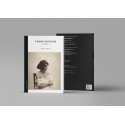Issue 8 of Found Footage Magazine, which is a printed film studies journal distributed worldwide. It offers theorical, analytical and informative content related to found footage filmmaking practices. Text in English with full-color photos.
 Our terms and conditions of use
Our terms and conditions of use
(edit with the Customer Reassurance module)
 Delivery policy
Delivery policy
(edit with the Customer Reassurance module)
FFM fills the void created by the fact that there has not been, up to this time, any forum for the collection and dissemination of information, critical thinking, and discussion of found footage cinema including all its manifestations : recycled cinema, essay film, collage film, compilation film, archival cinema, mash-up...
FFM accomodates a selection of articles and sections aimed at exploring issues of ethics, politics, form and content related to the culture of recyled cinema : monographs, interdisciplinary essays, interviews and opinion pieces concerning the eclectic universe of found footage film-making.
Index :
Special on Abigail Child
Abigail Child: We cannot control the pacing of this movie, by Gracia Ramírez
Watching an Abigail Child film for the first time feels like being bombed, tricked and tickled all at once. She interweaves seemingly unending arrays of stimuli drawn from bottomless piles of culture, all sources levelled up. She arranges them in sequences and submits them to layering, constant interruptions and repetitions, like someone tuning the radio, or hopping back and forth between TV channels. Sometimes there is synchrony between sound and image, or some continuity in the ordering of space and time—conventional cinematic cues that prompt the mind to search for meaning, recognize patterns and anticipate effects. But before we get too comfortable and savvy, Child thwarts those expectations and forces us to think again. Over the last forty years, she has used her multiple creative practices to explore meaning and culture in both serious and playful ways. Her work started to break new ground in the 1980s, engaging with the cultural voracity of the all-consuming eyes and ears of the multichannel TV generation, and with the DIY attitude and wholesale rejections of punk.
Through Child’s work we can see ways in which ideas, texts and audiovisual images are adopted, adapted and shared in popular culture, resulting in a sustained argument about how culture is comprised of a never-ending process of circulation and connection.
‘I want to speak with my time’ radical biography in Abigail Ahild’s Acts and Intermissions, by Jeffrey Skoller
Poetic questions and empathic ruptures: The Future Is Behind You, by Maureen Turim
The Suburban Trilogy: Abigail Child’s Cake and Steak, by Rachel Garfield
A little of the transcendental universe of Abigail Child, an interview by Camilla Margarida
ESSAYS
Stan VanDerBeek's Danse Macabre: Found sound, appropriated music, and rehearing, by Michael Betancourt
Into the Unknown known: Images of depersonalized people in post-socialist found footage films, by Lukas Brasiskis
Re-Enacting the Archives in Sam Ashby's The Colour of His Hair, by Matthew LaPaglia
American History Recontextualized: James Benning's American Dreams (Lost and Found), by Theodore Xenophontos
BOOK REVIEWS
Making Images Move: Handmade Cinema and the Other Arts, by César Ustarroz
Persistent Images: Encountering Film History in Contemporary Cinema, by Matthew Cole Levine
DÉMONTAGE: WHITE AFRO, by Akosua Adoma Owusu




